Edit: As we approach 4/10 and the 50th anniversary we start to see more on the subject. This from the facebook page of the Batfish. Seems simple and interesting:
http://www.facebook.com/pages/Muskogee-War-Memorial-Home-of-the-USS-Batfish/72015917108
My old submarine is a museum boat at Patriots Point in Charleston S.C. She is tied to the pier and rusting away as you can see. Every now and then I get a phone call from a young man who is going through a qualifications process that is training him to serve as a guide for tourists who visit the boat. He is interested and interesting. That can make for some long discussions but I have unlimited minutes on my phone. Last night I ran the battery down.
It is approaching the 50th anniversary of the loss of the Thresher (SSN593). We had turned to discussing the pressure that exists when a submarine dives and the two subjects certainly belong together. I thought that it might be appropriate to put it on the blog. This is it.
In 1967 we also lost the Scorpion. I found some pictures of the Thresher and Scorpion. In both cases a before and after picture. A submarine goes through some unreal pressures and generally people don’t think about them. I looked at that pressure using assumptions that are based on known dimensions of a type of sub with which I am familiar. A WW2 era Balao class Diesel Electric submarine. A nuclear boat is in a much more extreme situation. It is bigger (more pressure) and it dives deeper.
If you are interested in what life on a submarine might be like and/or how they function perhaps these two links will help, I wrote two articles on the subject but not involving wrecks. Curiously enough they are on a classic car site. The first one describes how a WW2 boat was made and the second was how they evolved during the cold war.
http://www.curbsideclassic.com/automotive-histories/diesel-electric-submarines-worlds-biggest-hybrids/
http://www.curbsideclassic.com/dockside-classic/dockside-classic-acceleration-from-zero-to/
This article includes a depth pressure table and other links you can follow on these wrecks.
http://www.facebook.com/pages/Muskogee-War-Memorial-Home-of-the-USS-Batfish/72015917108
My old submarine is a museum boat at Patriots Point in Charleston S.C. She is tied to the pier and rusting away as you can see. Every now and then I get a phone call from a young man who is going through a qualifications process that is training him to serve as a guide for tourists who visit the boat. He is interested and interesting. That can make for some long discussions but I have unlimited minutes on my phone. Last night I ran the battery down.
It is approaching the 50th anniversary of the loss of the Thresher (SSN593). We had turned to discussing the pressure that exists when a submarine dives and the two subjects certainly belong together. I thought that it might be appropriate to put it on the blog. This is it.
In 1967 we also lost the Scorpion. I found some pictures of the Thresher and Scorpion. In both cases a before and after picture. A submarine goes through some unreal pressures and generally people don’t think about them. I looked at that pressure using assumptions that are based on known dimensions of a type of sub with which I am familiar. A WW2 era Balao class Diesel Electric submarine. A nuclear boat is in a much more extreme situation. It is bigger (more pressure) and it dives deeper.
If you are interested in what life on a submarine might be like and/or how they function perhaps these two links will help, I wrote two articles on the subject but not involving wrecks. Curiously enough they are on a classic car site. The first one describes how a WW2 boat was made and the second was how they evolved during the cold war.
http://www.curbsideclassic.com/automotive-histories/diesel-electric-submarines-worlds-biggest-hybrids/
http://www.curbsideclassic.com/dockside-classic/dockside-classic-acceleration-from-zero-to/
This article includes a depth pressure table and other links you can follow on these wrecks.
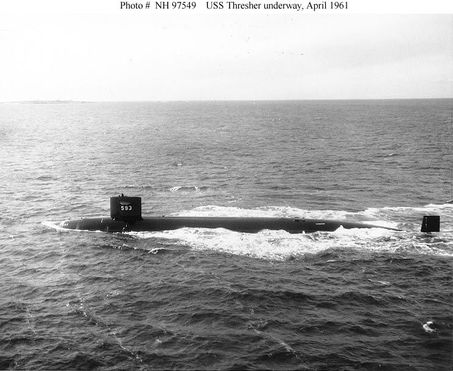
This is the U.S.S. Thresher SSN593. She was the lead boat of the thresher class. She went down in April 1963 with all hands on board. It is not a long time from the 1954 launch of the Nautilus to 1963 but it felt like it. Until the Thresher sank there had been a perfect record of no losses in our nuclear fleet. A board of inquiry was convened and they were able to recover noises of the thresher imploding that allowed them to put together a picture of what happened.
This site https://www.designed4submariners.com/Diesel_Boat_html.html has information that actually refutes some of the findings of the board of inquiry. The story is listed under "message" in the table of contents.
Another article that I found interesting is here: http://en.wikipedia.org/wiki/USS_Thresher_%28SSN-593%29 .
The class name was changed to the Permit class after the USS Permit (SSN594) following the loss of the Thresher.
This site https://www.designed4submariners.com/Diesel_Boat_html.html has information that actually refutes some of the findings of the board of inquiry. The story is listed under "message" in the table of contents.
Another article that I found interesting is here: http://en.wikipedia.org/wiki/USS_Thresher_%28SSN-593%29 .
The class name was changed to the Permit class after the USS Permit (SSN594) following the loss of the Thresher.
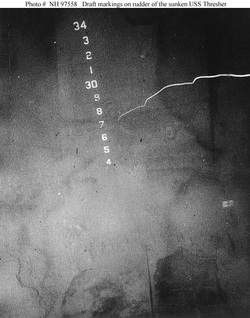
This is a picture of some debris that was left by the thresher (part of the rudder). The debris field is extensive. Although there is a lot of debris there were no bodies. When you read the math on the pressures encountered it will be easy to understand why. However, I was surprised to see no human artifacts so suspect there may be some censorship involved.
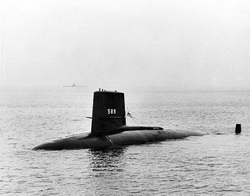
The scorpion was a Skate class boat. There were many subsafe alterations that were mandated after the loss of the Thresher. Then those measures were canceled for the Scorpion. Her yard overhaul was shortened and she was sent to the Med. She had just finished that med cruise when she sank. The Clamagore (my boat) pulled into Portsmouth England on the day the Scorpion was declared lost. This article contains a lot of information on that loss.
http://en.wikipedia.org/wiki/USS_Scorpion_%28SSN-589%29
http://en.wikipedia.org/wiki/USS_Scorpion_%28SSN-589%29
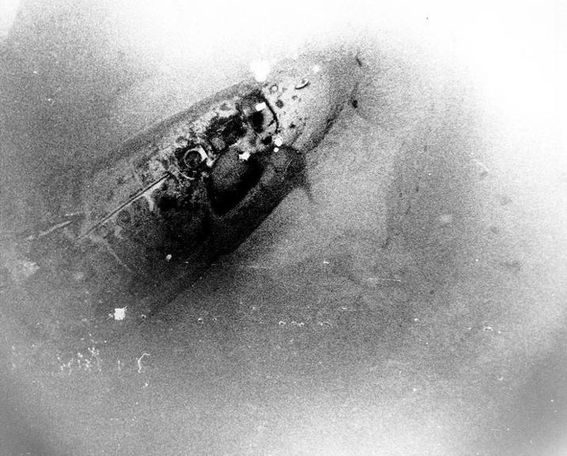
http://www.subasepearl.com/pages/Loss_of_the_USS_Scorpion_%28SSN-589%29
This is a short article that talks about the loss of the Scorpion. I suppose it is more from the survivor aspect-that of the surviving families. There is also a reasonable amount of personal opinion. That is to be expected and the truth is that nobody really knows the the crew members are not talking. One supposes it doesn't take too much imagination to see the bow of the scorpion in the picture above.
Now I would like to go to some things that I do know about. The pressures encountered at certain significant depths. When you read about them it is also necessary to know that there are currents encountered so this is not static pressure. The pieces of wreckage are twisted for a reason.
You and I are subjected to a lot of pressure just walking around. There are 14.7 pounds for every square inch of us. Some of us have more square inches than others but there is a lot of weight on each of us. If you just measure your waist and multiply times your height (minus head and neck) you will be somewhere in the ballpark. Multiply those square inches by 14.7 and you have the atmospheric pressure (in pounds) that are on you. It doesn’t hurt you because that pressure is equalized inside the body as well. Diving to the bottom of the pool and hearing your ears pop should prove that. That equalization of pressure also allows fish to swim at near the bottom of the marianas trench. A sub does not have the benefit of being allowed to equalize. There is one atmosphere of pressure inside the boat when it dives. Ideally, it remains unchanged. If that were not so they would not surface again. The crew would be dead long before they could.
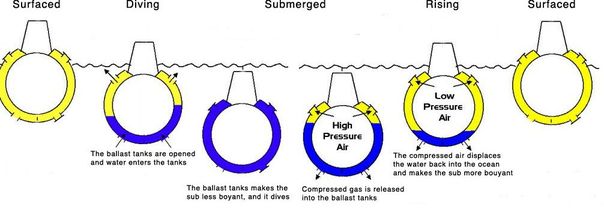
Your calculations probably won’t be very accurate but neither will mine. I intend to err on the conservative side and will explain as I go but I hope you can get some grasp of the enormity of the pressures involved.
http://www.fleetsubmarine.com/balao-class.html gives the beam of a balao type submarine as 27 ft. The beam is the widest part of the boat. 27 feet doesn’t mean much because it contains the ballast tanks.This illustration shows how a submarine gives itself positive or negative buoyancy. More importantly for the purposes of this article, the pressure hull is the circle inside the tanks. For the purpose of this article I am going to use 20 feet as the diameter of this circle. If I am wrong here it really only changes one column on the graph.
http://www.fleetsubmarine.com/balao-class.html gives the beam of a balao type submarine as 27 ft. The beam is the widest part of the boat. 27 feet doesn’t mean much because it contains the ballast tanks.This illustration shows how a submarine gives itself positive or negative buoyancy. More importantly for the purposes of this article, the pressure hull is the circle inside the tanks. For the purpose of this article I am going to use 20 feet as the diameter of this circle. If I am wrong here it really only changes one column on the graph.
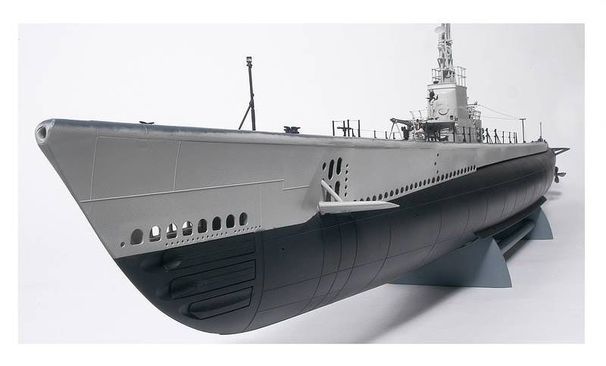
What you think of as the body of a ship in a picture of a WW2 sub is really mostly “bolt on” free flooding stuff. I used this picture of a model because you can see the line of limber holes that allow the deck areas to fill with water when you dive. There are lockers inside that contain much of the deck force equipment like mooring lines. The soft outer hull can equalize with outside pressure just like you and I or the fish at the bottom of the trench.
If you actually followed the link right above you already know that this hull displaced 1800 tons of water on the surface (2400 just barely submerged). In the picture of this model you can see the limber holes that allow the superstructure to free flood. The curving tube under it is the row of tanks you saw in the illustration of the hull and tanks. Inside that is the pressure hull that has to withstand the pressure.
Something that I saw done frequently is that the old hands would tie a string to a valve on each side of the ship and draw it very tight. The first time I saw this done we were just leaving the Naval Shipyard at Portsmouth New Hampshire (actually Kittery Maine). It remains tight on the surface but when you dive it is a different story. As you dive it will start to become slack as the pressures compress the hull. It is very sobering to a newbie.
There are a number of formulas that allow you to get the pressure at depth. One simple way is that each 33 feet equals one atmosphere (14.7 psi) of pressure. I don’t know about you but too many PSI’s or square inches will make my head hurt so we will get to square ft and tons before we are done. Just so I don’t have the dimensions wrong we will make this a pretend sub.
I do not intend to get lost worrying about the square inches on the surface of a sub so we shift now to square feet. The waist (beam) of this submarine is supposedly 27 ft. The only part that means anything is the hull under the soft tanks that one can see. My guesstimation is that the pressure hull is about 20 feet from side to side.
Every sub is different so let us just use my assumption. The ship is 312 ft long (Clamagore and other Guppy III were about 15 ft more). I will try to correct for a slight taper at the ends by cutting the length to 300 ft. That is somewhere in the correct neighborhood.
Using the formula that circumference equals (Pi) (d) we wind up with:
3.14 X 20= a waist of 62.8 linear ft
To find the total area multiple the circumference by the length
62.8 X 300 = 18,840 square feet or 1.884 X 10 4th power.
There are .445 pounds per each square inch per ft depth. There are 144 square inches per sq. ft. 1 square foot therefore has 64.08 pounds per foot depth.
Therefore, obviously a cubic foot of water should weigh 64.08 lbs. Standard salinity salt water at 40 degrees is just that.
If you actually followed the link right above you already know that this hull displaced 1800 tons of water on the surface (2400 just barely submerged). In the picture of this model you can see the limber holes that allow the superstructure to free flood. The curving tube under it is the row of tanks you saw in the illustration of the hull and tanks. Inside that is the pressure hull that has to withstand the pressure.
Something that I saw done frequently is that the old hands would tie a string to a valve on each side of the ship and draw it very tight. The first time I saw this done we were just leaving the Naval Shipyard at Portsmouth New Hampshire (actually Kittery Maine). It remains tight on the surface but when you dive it is a different story. As you dive it will start to become slack as the pressures compress the hull. It is very sobering to a newbie.
There are a number of formulas that allow you to get the pressure at depth. One simple way is that each 33 feet equals one atmosphere (14.7 psi) of pressure. I don’t know about you but too many PSI’s or square inches will make my head hurt so we will get to square ft and tons before we are done. Just so I don’t have the dimensions wrong we will make this a pretend sub.
I do not intend to get lost worrying about the square inches on the surface of a sub so we shift now to square feet. The waist (beam) of this submarine is supposedly 27 ft. The only part that means anything is the hull under the soft tanks that one can see. My guesstimation is that the pressure hull is about 20 feet from side to side.
Every sub is different so let us just use my assumption. The ship is 312 ft long (Clamagore and other Guppy III were about 15 ft more). I will try to correct for a slight taper at the ends by cutting the length to 300 ft. That is somewhere in the correct neighborhood.
Using the formula that circumference equals (Pi) (d) we wind up with:
3.14 X 20= a waist of 62.8 linear ft
To find the total area multiple the circumference by the length
62.8 X 300 = 18,840 square feet or 1.884 X 10 4th power.
There are .445 pounds per each square inch per ft depth. There are 144 square inches per sq. ft. 1 square foot therefore has 64.08 pounds per foot depth.
Therefore, obviously a cubic foot of water should weigh 64.08 lbs. Standard salinity salt water at 40 degrees is just that.
Depth PSI Lbs Sq Ft Tons Sq Foot Total Tons
1 ft .445 64.08 NA NA
100ft 44.5 6,408 3.2 60,160
400 178 25,632 13.0 241,000
1000 445 64,080 32.0 602,352
2400 1,068 153,792 76.9 1,445,645
1 ft .445 64.08 NA NA
100ft 44.5 6,408 3.2 60,160
400 178 25,632 13.0 241,000
1000 445 64,080 32.0 602,352
2400 1,068 153,792 76.9 1,445,645
It is no longer classified that the maximum allowed depth on a balao type sub is 400 feet. As you can see there is a tremendous weight on the pressure hull at 1000 feet. This is weight that a nuclear boat was designed to handle or thereabouts. I have never been on a Nuclear Submarine and I really am not going to get lost (or in trouble) talking about their test depth. If you have read the links you already know that the Thresher last communicated that they were passing 900 feet. That is public information.
I find the pressures at that depth to be amazing. Then it proceeded to go to crush depth which was calculated to be 2,400 feet. At 32 tons per square foot I don’t think you will find many human remains. The weight is not static. There are currents that must have twisted the wreckage as well. Take a look at the weight listed in the title of your car and calculate the weight of how many of your cars were on each square foot and twisting as the push.
At 76.9 tons per square foot when the ship imploded it is hypothesized that the air would instantaneously have become superheated and incinerate anything it found. It would have taken less than 100 milliseconds for the pressure inside the boat to have equalized and the boat would have been rent asunder and water would have been everywhere. In the seven minutes that the boat was descending to 2400 feet everyone in the crew must have known what was inevitable. However, when the pressure hull imploded death would have happened so swiftly that nobody knew it.
To truly understand this you would have had to be on the ship. A lot of experts have differing opinions. I have no opinions as to what happened but I have a deep respect for the people who put these machines together. There is a saying among submariners that it is important to keep your surfaces equal to your number of dives. It is a marvelous machine that can do that.
I find the pressures at that depth to be amazing. Then it proceeded to go to crush depth which was calculated to be 2,400 feet. At 32 tons per square foot I don’t think you will find many human remains. The weight is not static. There are currents that must have twisted the wreckage as well. Take a look at the weight listed in the title of your car and calculate the weight of how many of your cars were on each square foot and twisting as the push.
At 76.9 tons per square foot when the ship imploded it is hypothesized that the air would instantaneously have become superheated and incinerate anything it found. It would have taken less than 100 milliseconds for the pressure inside the boat to have equalized and the boat would have been rent asunder and water would have been everywhere. In the seven minutes that the boat was descending to 2400 feet everyone in the crew must have known what was inevitable. However, when the pressure hull imploded death would have happened so swiftly that nobody knew it.
To truly understand this you would have had to be on the ship. A lot of experts have differing opinions. I have no opinions as to what happened but I have a deep respect for the people who put these machines together. There is a saying among submariners that it is important to keep your surfaces equal to your number of dives. It is a marvelous machine that can do that.
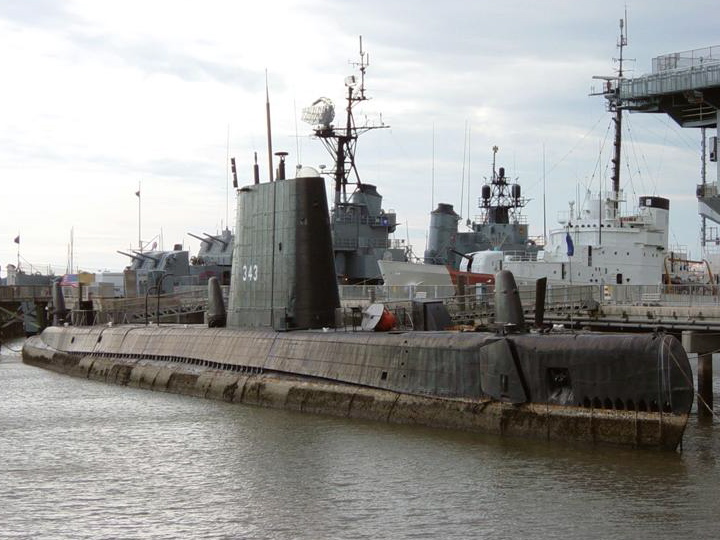
 RSS Feed
RSS Feed